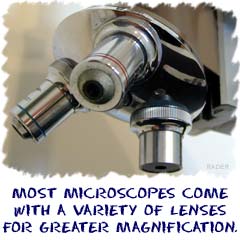The Littlest Organisms
Let's study the wee ones of the world known as the microbes or the microorganisms. If you spend your life studying them, you would be a microbiologist. These are the smallest of the small and the simplest of the simple. Some of them, like viruses, may not even be alive as we currently define life.
What is a Microbe?
What makes a microbe? We suppose you need a microscope to see them. That's about it. There is a huge variety of creatures in this section. They can work alone or in colonies. They can help you or hurt you. Most important fact is that they make up the largest number of living organisms on the planet. It helps to be that small. It's not millions, billions, or trillions. There are trillions of trillions of trillions of microbes around the Earth. Maybe more.Calling all Microscopes
As with all of science, discovery in biology is a huge thing. While microbes like bacteria, fungi, some algae, and protozoa have always existed, scientists did not always know they were there. They may have seen a mushroom here or there, but there were hundreds of thousands of species to be discovered. It took one invention to change the way we see the world of microbes - the microscope. In 1673, Anton von Leeuwenhoek put a couple of lenses together and was able to see a completely new world. He made the first microscope. It wasn't that impressive, but it started a whole history of exploration. More important to us, scientists were eventually able to discover the cause and cure of many diseases.
It took one invention to change the way we see the world of microbes - the microscope. In 1673, Anton von Leeuwenhoek put a couple of lenses together and was able to see a completely new world. He made the first microscope. It wasn't that impressive, but it started a whole history of exploration. More important to us, scientists were eventually able to discover the cause and cure of many diseases. Too Many to Count, Too Small to Find
We'll give the big overview on the variety of microorganisms here. There is no simple explanation of a microbe besides the fact that they are small. The list goes on. Just remember that there is a lot of variety going on here.They can be heterotrophic or autotrophic. These two terms mean they either eat other things (hetero) or make food for themselves (auto). Think about it this way: plants are autotrophic and animals are heterotrophic.
They can be solitary or colonial. A protozoan like an amoeba might spend its whole life alone, cruising through the water. Others, like fungi, work together in colonies to help each other survive.
They can reproduce sexually or asexually. Sometimes the DNA of two microbes mixes and a new one is created (sexual reproduction). Sometimes a microbe splits into two identical pieces by itself (asexual reproduction).
No comments:
Post a Comment